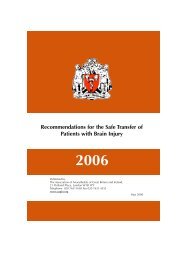TheatrePracticeStandardsGeneric1
Create successful ePaper yourself
Turn your PDF publications into a flip-book with our unique Google optimized e-Paper software.
A patient who remains hypotensive despite resuscitation must not be<br />
transported until all possible causes of the hypotension have been<br />
identified and the patient stabilised.<br />
Correction of major haemorrhage takes precedence over transfer. It is<br />
important that these measures are not omitted in an attempt to speed<br />
transfer of the patient, as resultant complications may be impossible to<br />
deal with once the journey has begun.<br />
Persistent hypotension will adversely affect neurological outcome.<br />
When other causes of hypotension have been excluded, consider the<br />
judicious use of inotropes/vasopressors to offset the hypotensive effects<br />
of sedative agents.<br />
If the patient has had a seizure, loading with anticonvulsant agents<br />
(usually phenytoin) should be considered prior to transfer. Unstable or<br />
compound long bone fractures should have preliminary toilet and be<br />
splinted to provide neurovascular protection and analgesia.<br />
If the transfer team has not been involved in the initial stages they<br />
should familiarise themselves with treatment already given and<br />
independently assess the general status of the patient before departure.<br />
All lines and tubes must be fixed securely and ready access to them<br />
ensured.<br />
The transfer team should confirm the availability of an appropriate<br />
transfer vehicle and check the function of all equipment, including<br />
battery charge status.[14] Oxygen requirements for the journey<br />
including possible delays should be estimated and should include<br />
driving gas requirements of the ventilator. A minimum reserve of<br />
oxygen and drugs should be one hour or twice the estimated journey<br />
time. If transfer times are unduly long, it may be necessary to arrange<br />
for back up oxygen supplies to be made available en route if possible.<br />
Before departure, case notes, X-rays, a referral letter and investigation<br />
reports should be collated and any required blood or blood products<br />
collected. The neurosciences unit should be contacted and informed of<br />
the estimated journey time.<br />
10





